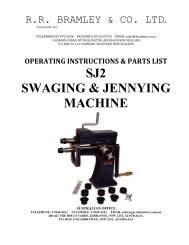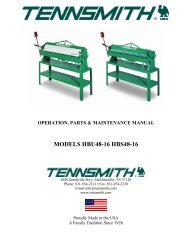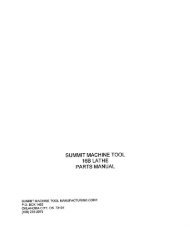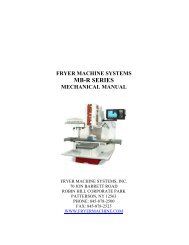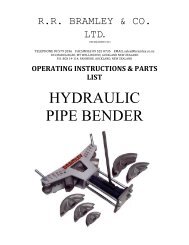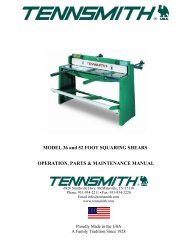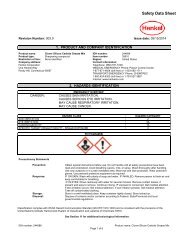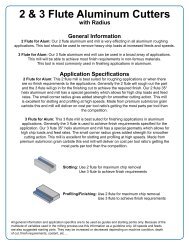You also want an ePaper? Increase the reach of your titles
YUMPU automatically turns print PDFs into web optimized ePapers that Google loves.
5. Emergency stop is press activated, shuttingdown the entire system. To restart the systemturn the knob clockwise and it will return toposition.6. The saw head control valve lowers theblade to the work piece.Open the valve slightly to lower the saw headslowly.Open the valve all the way for rapid saw headlowering. When sawing round or narrowwork, and only one or two saw teeth contactthe work piece, open the valve only slightly,bringing the blade into contact with the workpiece slowly.After the blade begins a kerf in the workpiece, open the valve and the metering valvetakes over for efficient sawing. See OtherControls no. 13, Sawing force adjustment.When automatic sawing with optional barfeed,adjust the saw head and blade just above thework piece and open the lowering valve forthe metering valve to take over. After eachcut the saw head raises, the work piecemoves into place for the next cut and the sawhead comes back down. See Other Controlsfor adjusting saw head raise height.To limit saw head rate of descent, adjust thevalve to the rate wanted.Caution: Do not adjust (optional) barfeedthrust force so much it would damage thestock stop switch, or light weight stock movinginto the stop.Adjust the control to less force for moving lightstock and greater force to move heavy stockup to the switch more quickly.OTHER CONTROLS not shown on page fiveinclude:Sawing force adjustment.Sawing force is a very important factor.Carefully determine proper sawing force forthe work piece.For fast, smooth sawing and lower cost percut, consult a reliable blade supplier. Thesupplier will make test cuts on the machineand the work piece with his recommendedblades.Normally a thin work piece section requires alight sawing force and a wide section greaterforce.However, as the blade guides spread widerfor bigger stock, a longer distance betweenthe guides, the blade loses some of its rigidity,or blade beam strength.On wide stock use a lighter sawing force anduse only new blades which require less forceto make a satisfactory cut. Applying moresawing force to penetrate a wide work piececauses blade run out--a crooked cut in thework piece.As blades dull sawing wide work, replacethem with sharp blades.Set dulled blades aside for sawing smallerwork where the short span between theguides provides greater saw blade beamstrength, rigidity, and make cuts withintolerance.Follow blade manufacturer instructions forbreaking in a new blade.For more details on sawing force, see BladeSelection <strong>Manual</strong> 900409 in this binder.Sawing force adjustment is at the meteringvalve dial on the right-side guide arm. Thedial reads 30 to 120 pounds of sawing force.To increase sawing force turn the adjustingthimble down the dial until the top of thethimble is at the proper sawing force for theblade and the work piece.The metering valve monitors the sawingforce, measuring work piece resistance tothe saw blade.Blade speed control is as important assawing force. Running a blade too fast forthe work piece burns the blade outprematurely.Increased surface speed of any cutting toolmakes the cutting edge run hot. Blade metaltemperature passes critical at a given point,the cutting edge softens and the tool fails.See the cutting chart mounted on themachine with recommended blade speedsfor most popular metals.Most blade suppliers furnish a slip chart withrecommendations for their blades. Page 10of the Saw Blade Selection manual offers aguide.Change blade speed only with the saw blademotor running. Loosen the thumb screwlocking nut and turn the selector hand wheelon the pulley shaft at the back of the sawhead until the indicator is at the blade speedwitness mark proper for the blade type andwork piece. When the desired blade speed isset, re-tighten the thumbscrew.Saw head cycle adjustment.During production sawing of small work it isnot necessary for the saw head to return theblade more than just enough to clear thework piece moving under the blade for the6



